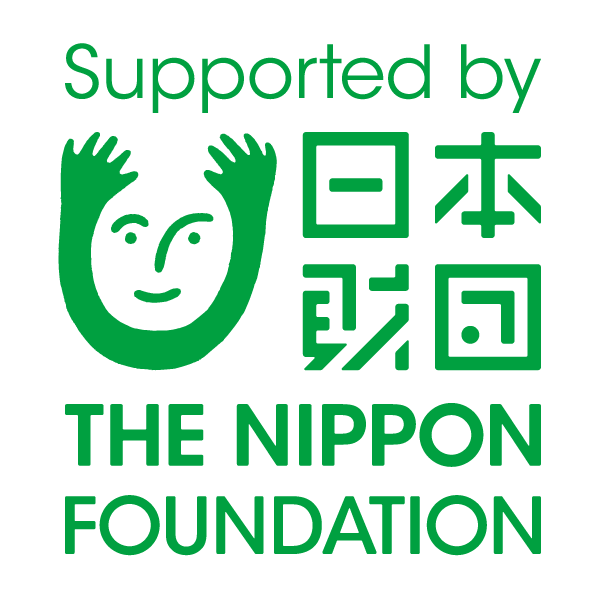Fortune Cookie Production at Benkyodo, San Francisco - ca 1914-1941 - WWII - 1946-1958

|
||
| Licensing | ||
This Album contains illustrations, photographs and explaination of what I remember of Benkyodo's production of fortune cookies after WWII.
This is a supplement to the two-part essay, "Japanese American Fortune Cookie," I wrote for the Discover Nikkei Journal.
The rough drawings are mine as I best recall what I witnessed in the late-40s - early 50's, when Benkyodo, my maternal grandfather's Japanese confectionary business was restarted following the Okamura and Ono families release from Amache, of the ten Concentration Camps of WWII America, with the help of my mother, Kim and father, Sam Masami Ono.
The pre-war sembei machine was reassembled in the second Benkyodo location, 1602 Geary Street Post-WWII. The photographs of the katas I took were in a storage area used by Benkyodo. The Meiji era woodblock print is from an article produced by Dr. Yasuko Nakamachi, then a graduate student of Kanagawa University, who's thesis was on the original Japanese fortune cookie, the Tsujiura Sembei.
Please check out the link below to access and read a more complete story about the origin of the fortune cookie. It was written in 2007 and describes the little known story of how a Japanese confectionary became the Chinese Fortune Cookie. Japanese American Fortune Cookie: A Taste of Fame or Fortune >>
Slides in this album |
|
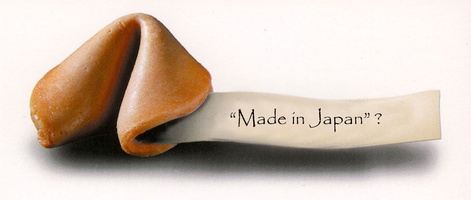
|
"Made in Japan"The title image implys correctly that the Fortune Cookie originated in Japan or is "Made in Japan." Although most Americans including Japanese Americans assumed that the fortune cookie is Chinese, it actually was invented in Japan in the early Meiji-era. The early version was a bit larger and the taste was … |
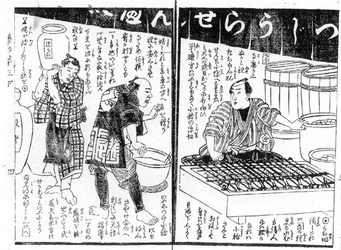
|
Meiji Era Woodblock Print of Tsujiura Sembei ShopDr. Yasuko Nakamachi, Kanagawa University wrote In her essay, “A Critical View of a Traditional Illustration,” Dr. Nakamachi reproduced this woodblock print from the National Diet Library, which was used to illustrate a story she cited from “Moshiogusa Kinsei Kidan (Moshiogusa Modern Amazing Stories), from the Meiji era, 1868-1912. The story …
woodblock print courtesy of National Diet Library, Tokyo] |
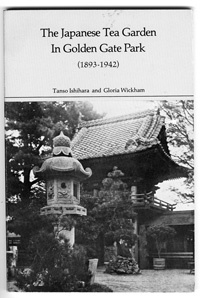
|
"The Japanese Tea Garden in Golden Gate Park - 1893-1941"In this book given to me by Tanako Hagiwara, the great granddaughter of Makoto Hagiwara, it basically states that, "It was the San Francisco Japanese Tea Garden founder, Makoto Hagiwara who introduced the Japanese Tsujiura Sembei to customers in his Tea Garden, in 1914, a year before the Panama-Pacific Exposition. Hagiwara served …
Book authors: Tanso Ishihara and Gloria Wickham |
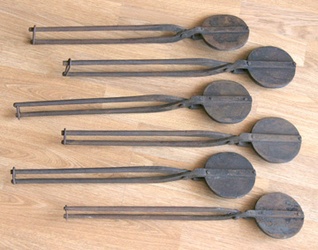
|
Benkyodo's KatasKata are individual baking irons or griddles that use to used to cook cookie dough singly. In Meiji-era Japan, bakers would have rows of Katas lined-up over a charcol grill and would turn them by their handles to bake on both sides. When baked, the baker would unclamp the Kata and … |
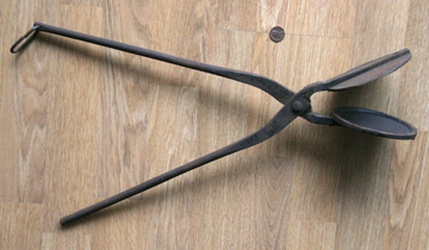
|
An Open KataThis kata is open to show how the plier-like device has a clamping mold inside which the Sembei is baked. A U.S. coin (one cent) is nearby to give scale to this cooking grille implement. The katas are stamped in Japanese in the handles with the tool maker's chop (ID). |
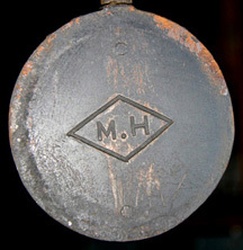
|
Engraved Kata MoldSome of the Katas (hand griddle) that were in Benkyodo's possession (six shown in another picture), had the initials MH engraved inside. I verified with Tanako Hagiwara, great grandaughter of Makoto Hagiwara, that the initials stood for his name. I conjecture that Makoto Hagiwara, whose Japanese Tea Garden used to … |
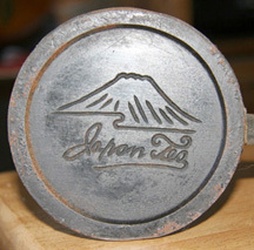
|
Kata with engraving of Japan Tea in front of Mt. FujiLike the kata with the engraved M.H., some had Japan Tea and a stylized drawing of Mt. Fuji engraved inside. According to testimonies, Makoto Hagiwara, 1893 founder and caretaker of the the Japanese Tea Garden in San Francisco's Golden Gate Park, formally introduced Green Tea to America along with the … |
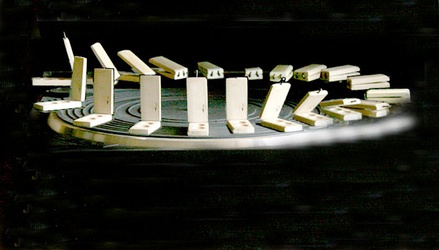
|
Photo-montage of the Sembei baking grills opening and closing.With a single hand-made miniature wooden model of a clam shell-like baking griddle, multiple images of the wooden model (griddle) were photographed in different angles of openess and closure to make it appear that the griddles were opening and closing, as they would in the drawing of the Sembei cooking machine. The griddle model was placed on a record … |
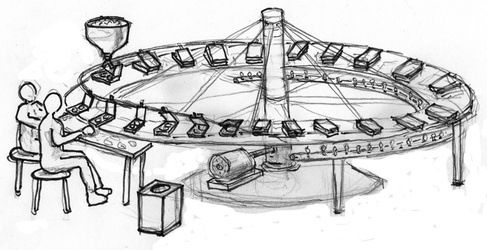
|
Drawing of Sembei Baking MachineThe actual griddles were made of cast iron and rested on a steadily rotating circular stage above a section of a gas-flame burner, which baked the cookie dough inside. A metal peg on the tip of the griddle upper section rode on a metal track that opened and allowed for the … |
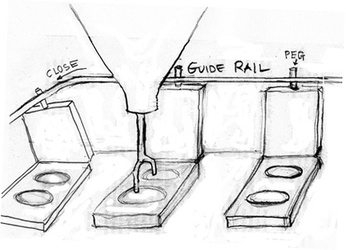
|
Sembei Dough Pours into GriddleThis drawing shows a closer view of roughly how I recall how the Sembei cookie dough was poured into the Sembei griddle mold/ |

|
Picking Out the Hot Baked SembeiI recall bakery workers using a pick to pluck-out the hot Sembei before putting in the fortune slip in and folding them. |
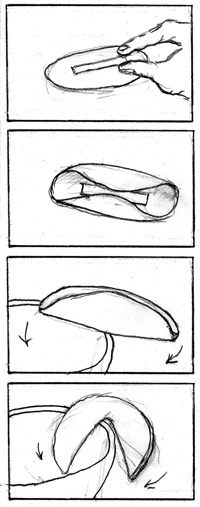
|
Fortune Cookie SlipThis just shows basic steps how the round flat Sembei is folded to hold the fortune slip and the lower drawing shows how the cookie could be encouraged to fold-back enveloping the fortune slip inside. After the folded cookie is cooled, you have a delicious ready to eat fortune cookie! |
 garyono
garyono
 Jack Muro Amache Photo Album
Jack Muro Amache Photo Album Letters From Camp
Letters From Camp ShastaYama 2007
ShastaYama 2007
 Journal feed
Journal feed
